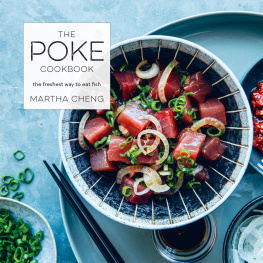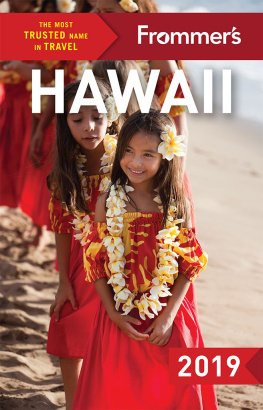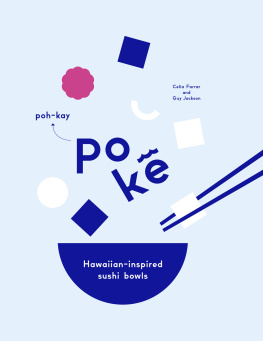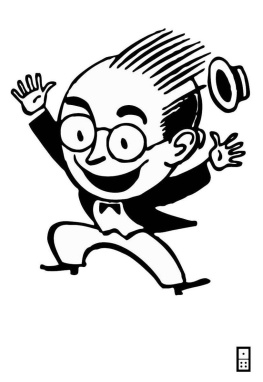ACKNOWLEDGMENTS Thank you to my editor, Amanda Englander, whose idea this book was, and to the rest of the team at Clarkson Potter: Stephanie Huntwork, Christine Tanigawa, Philip Leung, and Alexandria Martinez. Thanks to all my tasters and testers: Dustin Chang, Jill Dwornik, Dabney Gough, supertester Beau Smith, and supertaster Kelly Tam Sing, for trying all the poke, the good and the bad, though at least I spared you the clams! Thank you, Ben Trevino, for the cocktail ideas and for pretending you liked poke that first time. Jennifer Hee and Ashley Lukens: I cant shoyu enough love. Thanks, Mom and Dad, for scouting all those seafood counters. Susanna Ok, thank you for teaching me how to make poke, almost ten years ago(!).
MARTHA CHENG is a Honolulu-based food writer, contributing to publications such as Eater, Cond Nast Traveler, and Frommers.
MARTHA CHENG is a Honolulu-based food writer, contributing to publications such as Eater, Cond Nast Traveler, and Frommers.
She was the food editor at Honolulu magazine for nearly four years, and before that worked in kitchens, food trucks, and bakeries in Hawaii and Northern California.

The recipes in this chapter represent the varieties of poke youll find all across Hawaiithe ones that, for locals, taste like home. The most extensive poke counters, inside supermarkets and specialty stores, may offer as many as thirty different poke, but theyre mostly variations on these basic recipes, with all sorts of seafood and non-seafoodeverything from smoked fish to imitation crab to edamamepaired with the classic sauces. SPICY AHI SERVES 4 Nose-to-tail cooking? It applies to fish, too! Restaurants in Hawaii often receive deliveries of entire sides of ahi, or even the whole fish, and none of it goes to waste. Ive eaten roasted ahi collars the size of rib-eye steaks anda local favoritefried ahi belly. When I worked at the Pineapple Room, once we filleted the fish, we would scrape the meat off the bones and from the sinewy belly and mix it with sriracha and mayo for family meal.
We couldnt get enough of it. But the sauce is so good, it cant be confined to the trimmings; youll see prime cuts of fish used to make this popular poke all over Hawaii. This recipe also works well with crab (its especially popular with imitation crab) and with quick-poached scallops. 1 pound sushi-grade tuna, cut into -inch pieces + cup thinly sliced scallions (green parts only) + cup mayonnaise + cup masago + 4 teaspoons sriracha + 1 teaspoon soy sauce + teaspoon fine-grain sea salt, plus more to taste In a medium bowl, combine all the ingredients. Fold gently until thoroughly mixed. Serve immediately, or cover tightly and refrigerate for up to a day.
If you let the poke marinate, taste it again right before serving; you may need to season it with a pinch more salt. LIMU AHI SERVES 4
Sometimes called Hawaiian-style poke, limu ahi poke is the closest most people will get to the original preWestern contact dish, which was often made of chopped reef fish, sea salt,
limu (seaweed), and
inamona (a condiment of crushed roasted candlenut). While theres a whole range of seaweeds in Hawaiiat one time, there were an estimated seventy edible types, from soft and fuzzy to fine and hairlikethe variety usually used in poke these days is thicker, adding crunch and a distilled taste of the sea. 1 pound sushi-grade tuna, cut into -inch pieces + cup chopped limu + cup thinly sliced scallions (green parts only) + 2 teaspoons inamona + 1 teaspoon alaea salt or coarse sea salt, plus more to taste + teaspoon crushed red pepper flakes In a medium bowl, combine all the ingredients. Fold gently until evenly distributed. Taste, and adjust with more salt as desired.
Serve immediately, or cover tightly and refrigerate for up to a day. If you let the poke marinate, taste it again right before serving; you may need to season it with a pinch more salt. CANT FIND IT? Limu is sometimes sold at Japanese supermarkets, but if its unavailable, you can substitute the sweet and crunchy seasoned seaweed salad sold there. Inamona can be replaced with finely chopped toasted macadamia nuts. SHOYU AHI SERVES 4
This is the classic poke, the one that you probably think of when you hear the word. It showcases the evolution of the dish over the decades, with the more prized ahi tuna replacing bony reef fish, the nutty richness of sesame oil stepping in for inamona, crunchy raw yellow onion replacing the limu, and shoyu (soy sauce)a staple in Hawaii, thanks to the Japanese-influenced culturefor salt.
At popular poke counters, youll find this base mixed with all sorts of seafood, such as salmon, kajiki (blue marlin), or abalone, and even non-seafood, like tomatoes or edamame. 1 pound sushi-grade tuna, cut into -inch pieces + cup thinly sliced yellow onion + cup thinly sliced scallions (green parts only) + 2 tablespoons soy sauce, plus more to taste + 1 teaspoon toasted sesame oil + teaspoon sambal oelek In a medium bowl, combine all the ingredients. Fold gently until evenly distributed. Taste, and adjust with more soy sauce as desired. Serve immediately, or cover tightly and refrigerate for up to a day. If you let the poke marinate, taste it again right before serving; you may want to add another splash of soy sauce.
WASABI AHI SERVES 4 As any sushi-lover knows, wasabi and raw fish are a natural pairing. Think of this poke as an unfussy version of sashimi, seasoned and mixed and ready for a picnic at the beach. For a tasty variation, try it with pickled jalapeos instead of fresh. 2 tablespoons soy sauce, plus more to taste + 2 teaspoons wasabi paste + 1 pound sushi-grade tuna, cut into -inch pieces + cup chopped scallions (green parts only) + cup thinly sliced yellow onion + 1 jalapeo, seeded and thinly sliced In a small bowl, whisk together the soy sauce and wasabi. In a medium bowl, combine the tuna, scallions, onion, jalapeo, and the wasabi-soy mixture. Fold gently until thoroughly mixed.
Serve immediately, or cover tightly and refrigerate for up to a day. If you let the poke marinate, taste it again right before serving; you may want to add another splash of soy sauce. TERIYAKI SALMON AND AVOCADO SERVES 4 Teriyaki could be called Hawaiis barbecue sauce: youll find teri beef, teri chicken, and teri burgers on the grill and as a part of plate lunchesthe local classic meal of two scoops rice, one scoop mac salad, and meat. On weekends, when everyone has a grill set up near the sand, the beach breezes waft teriyaki sauce. So where better to enjoy this poke than at your next barbecue? Its a blend of sweet and salty and creamy, thanks to a homemade teriyaki sauce and buttery avocado. Its definitely worth taking the extra few minutes to make your own teriyaki saucesearching for an adequate store-bought version is like being Goldilocks in a sea of too thin, too salty, or too sweet condiments.
TERIYAKI SAUCE cup soy sauce + 1 tablespoon mirin + 1 teaspoons sugar + 1 teaspoon minced garlic + 1 teaspoon minced fresh ginger 1 pound salmon, cut into -inch pieces + 1 medium-size ripe avocado, diced + cup thinly sliced yellow onion + cup thinly sliced scallions (green parts only) Make the teriyaki sauce: Combine the soy sauce, mirin, sugar, garlic, and ginger in a small saucepan, and stir over medium heat until the sugar has dissolved. Pour into a medium bowl and let cool completely in the refrigerator, about 15 minutes. Add the salmon, avocado, yellow onion, and scallions to the cooled teriyaki sauce. Fold gently until thoroughly mixed. Serve this poke immediately, before the avocado oxidizes and turns brown. KIMCHI SALMON SERVES 4
Next page














